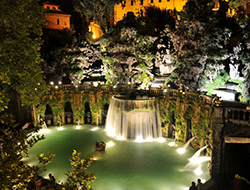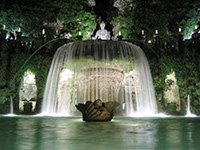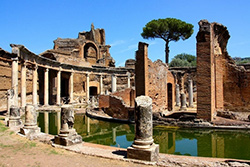Tivoli
The history
 Dates back to 1215 BC and takes its name from the hero Tibur which still retains, in addition to the name, countless historical mythological associations.
Dates back to 1215 BC and takes its name from the hero Tibur which still retains, in addition to the name, countless historical mythological associations.
The succession of historical epochs has left the city with a variety of evidence that cross the Middle Ages and the Renaissance coming to the present day.

The artistic heritage
In addition to the better known Adrian's Villa, Villa d'Este and Villa Gregoriana remember the Temple of Hercules Victor, now fully restored, the Roman Amphitheatre and Cathedral of San Lorenzo, the Tower Houses and Church of San Michele, Rocca Pia the Gregorian Bridge.From the Grand Tour to the present day
 With the artificial tunnels built by Pope Gregory XVI, 280 m long, more or less., Had gone to the dangers of flood risk from Tivoli and diverted the river. What emerged was the famous waterfall.
The project was completed in less than two years, from July 6, 1832.
With the artificial tunnels built by Pope Gregory XVI, 280 m long, more or less., Had gone to the dangers of flood risk from Tivoli and diverted the river. What emerged was the famous waterfall.
The project was completed in less than two years, from July 6, 1832.
Around this modification developed an interest for tourist that gradually contributed to the increase in the area. This constituted for the travelers of the Grand Tour and made the site a popular destination one of the major attractions of Tivoli.
You can still admire the precious details and artistic nature.
The Gregorian Bridge, the Grotto of Neptune, and the many tombstones registered in the name of emperors and empresses, kings and queens, found themselves in the beauty of the park the magic of the Italian landscape married to the impressive value of a long history.